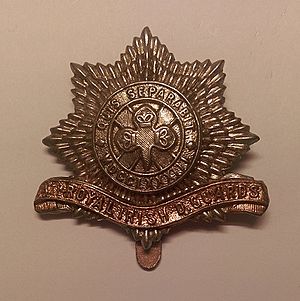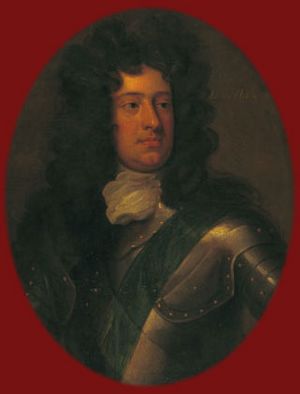4th Royal Irish Dragoon Guards facts for kids
Quick facts for kids 4th Royal Irish Dragoon Guards |
|
|---|---|

Badge of the 4th Royal Irish Dragoon Guards
|
|
| Active | 1685–1922 |
| Country |
|
| Branch | |
| Type | Cavalry |
| Role | Line Cavalry |
| Size | 1 Regiment |
| Nickname(s) | The Blue Horse, The Mounted Micks, The Buttermilks |
| Motto(s) | Quis separabit (Who shall separate us?) |
| March | Quick: St Patrick's Day Slow: 4th Dragoon Guards |
| Commanders | |
| Notable commanders |
Lieutenant-General James Hamilton, 4th Duke of Hamilton Field Marshal James O'Hara, 2nd Baron Tyrawley |
The 4th Royal Irish Dragoon Guards was a famous cavalry regiment in the British Army. It was first formed in 1685. Back then, it was called the Earl of Arran's Regiment of Cuirassiers. The regiment served for over 200 years, including during the First World War. In 1922, it joined with another regiment, the 7th Dragoon Guards (Princess Royal's). Together, they became the 4th/7th Dragoon Guards.
Contents
History of the Dragoon Guards

The regiment began in 1685. It was created by James, Earl of Arran. This happened during the Monmouth Rebellion, a time of conflict in England. The regiment was first known as the Earl of Arran's Regiment of Cuirassiers. It was ranked as the 6th Regiment of Horse.
Early Battles and Changes
The regiment fought in important battles. These included the Battle of the Boyne in July 1690. They also fought at the Battle of Steenkerque in August 1692. Both battles were part of the Williamite War in Ireland. In 1691, its rank changed to the 5th Horse. Then, in 1746, it moved to the Irish army and became the 1st Horse. In 1788, it returned to the British army. Its name changed to the 4th (Royal Irish) Dragoon Guards.
Fighting in the 18th Century
The regiment helped in the invasion of France in 1795. They supported French people who had left their country. Later, they fought in the Irish Rebellion. This included battles like Battle of Naas and Battle of Prosperous on May 24, 1798. They also fought at Battle of Tuberneering on June 4, 1798.
At Tuberneering, a group from the regiment faced a surprise attack. Their leader, Lieutenant-Colonel Walpole, and 100 men died. The regiment continued to fight. They were at the Battle of Arklow on June 9, 1798. They also fought at the Battle of Vinegar Hill on June 21, 1798.
19th Century Conflicts and Deployments
In 1811, the regiment went to the Peninsular War in Spain and Portugal. They fought at the Siege of Ciudad Rodrigo in January 1812. This was under General Sir John Slade. They also took part in the famous charge of the Heavy Brigade. This happened at the Battle of Balaclava in October 1854 during the Crimean War. Later, they fought at the Battle of Tel el-Kebir in September 1882. This was during the Anglo-Egyptian War.
After 1882, the regiment returned to the United Kingdom. They went back to Egypt from 1884 to 1885. Then, they were sent to Ireland in 1886. In 1891, they returned to England. By 1894, they were in British India. They were stationed in Rawalpindi and later in Muttra.
The First World War
When the First World War started, the regiment landed in France. This was on August 16, 1914. They were part of the 2nd Cavalry Brigade. This brigade belonged to the 1st Cavalry Division. They served on the Western Front.
One of their most important moments was on August 22, 1914. A group from the regiment became the first British soldiers to meet the German army. This happened near Mons at Casteau. Two British cavalry troops surprised four German cavalrymen. After a short chase, the British soldiers defeated most of the German patrol. Captain Charles Hornby is said to have been the first British soldier to kill a German soldier with his sword. Drummer Edward Thomas is believed to have fired the first British shots of the war.
In 1921, the regiment was renamed the 4th Royal Irish Dragoon Guards. In 1922, it joined with the 7th Dragoon Guards (Princess Royal's). They formed the 4th/7th Dragoon Guards.
Regimental Museum
The history and items of the regiment are kept at the York Army Museum. This museum is located at the Tower Street drill hall in York.
Battle Honours
Battle honours are special awards given to military units for their bravery in battle. Here are the honours for the 4th Royal Irish Dragoon Guards:
- Early Wars: Peninsular, Balaklava, Sevastopol, Tel-el-Kebir, Egypt 1882
- The Great War: Mons, Le Cateau, Retreat from Mons, Marne 1914, Aisne 1914, La Bassée 1914, Messines 1914, Armentières 1914, Ypres 1914 '15, St. Julien, Frezenberg, Bellewaarde, Somme 1916 '18, Flers-Courcelette, Arras 1917, Scarpe 1917, Cambrai 1917 '18, St. Quentin, Rosières, Amiens, Albert 1918, Hindenburg Line, Pursuit to Mons, France and Flanders 1914-18
See also





